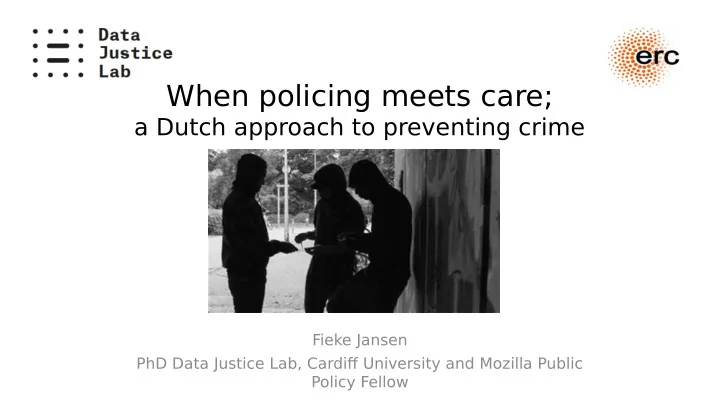

When policing meets care; a Dutch approach to preventing crime Fieke Jansen PhD Data Justice Lab, Cardifg University and Mozilla Public Policy Fellow
Positioning prevention Predictive policing; police are turning to data and technology to increase their efficiency and effectiveness. Emerging issues: Changing the nature of police from reactive → pre-emption Predict not who will commit crime but who will be arrested Technology of oppression → perpetuating, reinforcing and obscuring existing inequalities
Program Country Crime area Status Status Gang Matrix U.K. Gang Violent Identify and tracking individuals Temporarily suspended involved with gangs Offender management U.K. Acquisitive crime Identify and predict that a known In development / testing system crime offender will move to high harm offences Qlik Sense U.K. o.a HIC, vulnerable Identification and risk Active communities, stalking, assessment of victims and domestic violence perpetrators Domestic violence U.K Domestic abuse Identify and predict the risk of Development machine learning escalating repeat offences Top 600 NL HIC and drug & Identification of prolific repeat Active violence HIC offenders and those at risk of being recruited by drug cartels Top 400 | ProKid -12 NL HIC Signalling and identification of Active, Prokid -23 is in young adults who need care development RTI-Geweld NL Violent crime Identification of violent offenders Active Radar-IT Germany Terrorism Selection of individual on watch- Actice list most likely to commit violent crime
Pyramid of increasing complexity Manage crime Safety and care Signalling No intervention needed
Top 600 ● Political response by the the Mayor and the city of Amsterdam ● Cycle of enforcement and investigation is not successful ● Top 600 aim to reduce the number of HIC by identifying the most prolific repeat offenders and structurally intervening in their lives; 1) preventing crime by assessing the risk and then see how you can make it smaller, 2) changing the conditions of someone’s life with the focus on care 3) prevent the inflow of younger siblings by minimizing the impact of negative elements of a young criminal's life on their family. ● Housed in the city and collaboration of public authorities ● Data-driven risk scoring: ● 15.000 HIC offenders > 2000 – 3000 on police criteria > final 600 public prosecutor criteria
Person-oriented ● Challenge is to translate abstract problem to concrete criteria “There is a small group of big time drug criminals and cartels who recruit relative young guys, with minor criminal offences on their name, to sell drugs. Within no time they are given a gun and are involved in liquidations or told to hang a hand-grenade on a wall, a door handle or something like this” (CIO Top 600) ● Person-oriented approach ● Not an exact science ● A focus on ‘riskiness’ flattens the approach ● Individuals with complex problems ● Coordination between public authorities is key - ‘one government’ ● Expensive; public authorities need to invest a number of FTE, money and resources
Profiling the other ● Data-driven risk scoring primarily used to identify the most prolific HIC offenders and most at risk of being recruited by drug cartels ● Response is tailor-made and personal and should not be informed by data ● Limited evaluation on successfulness of interventions ● Anecdotal evidence shows ● The more positive factors the more effective the intervention ● Coordinating and streamlining of public assistance to the individual ● Debt relief is often crucial
‘One government’ ● Happens in a context of relatively little austerity ● Collaboration across public authorities is complex and challenging ● Need to find synergies across organizational mandates, cultures and approaches ● Hesitance in the top of police; responsibility and ownership ● Questioning the role of police in pre-emptive intervention ● How the ensure proper safeguards ● Focus primarily on procedural safeguards ● Justification and legitimacy of pre-emptive interventions ● Recourse possibilities for affected communities
General observations Data-driven risk scoring is primarily based on police data; ● Signal and refer to other public authorities ● Safety and care: identify and coordinate with other public authorities ● Repression: managing crime and keeping it small Data us used to profile the other not understand police’s actions Safeguards are primarily procedural One government approach; coordination or oppression? Responsibility is placed on politicians and society to discuss
Recommend
More recommend